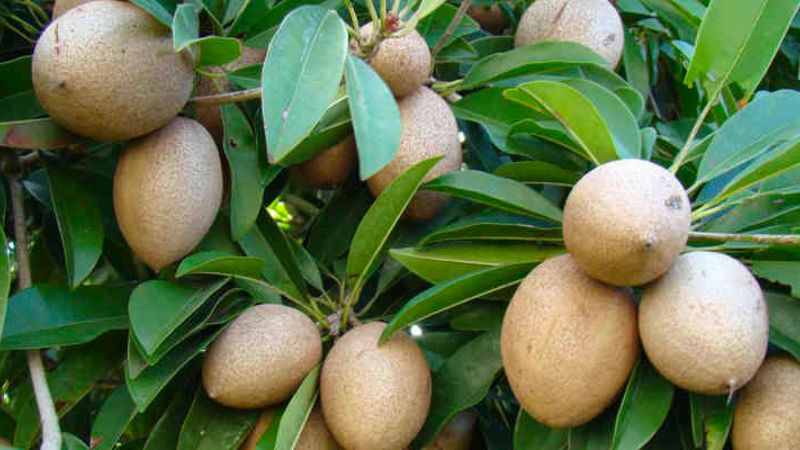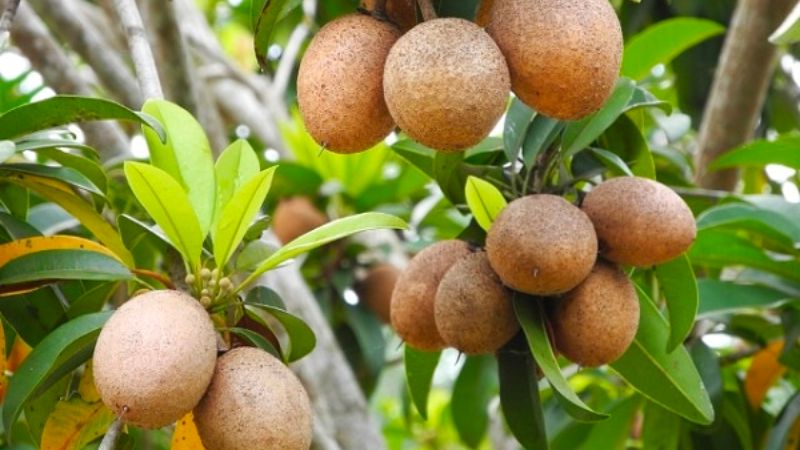The sapodilla tree, also known as sapoche or hong xiem in Vietnamese, is a tropical fruit-bearing tree native to Southern Mexico, Central America, and the Caribbean. It has been widely cultivated in tropical regions of Asia, particularly in Vietnam, Thailand, and Laos. This long-lived tree can grow to a height of 3-12 meters and bears sweet, nutritious fruit.
1 What is the Sapodilla Tree?
Origin and Significance
The sapodilla tree, scientifically known as Manilkara zapota, is an evergreen tree that thrives in warm, tropical climates. Its common names, sapoche and hong xiem, reflect its presence and popularity in Southeast Asia, particularly in Vietnam. The tree is known for its sweet, edible fruit, which has a brown outer shell and a succulent, reddish-brown flesh.
 Sapodilla fruit is packed with vitamins and nutrients
Sapodilla fruit is packed with vitamins and nutrients
Characteristics and Classification
Sapodilla trees typically grow to a height of 3 to 12 meters. Their leaves are a glossy green, elliptical or oval in shape, and measure 7-15 cm in length. The trees produce white flowers that give way to fleshy, brown-yellow fruits with a reddish-brown interior. The fruits are a good source of vitamins and have a sweet, malty flavor. The trees fruit twice a year, and their flowers can bloom throughout the year.
2 Benefits of the Sapodilla Tree
Both the fruit and the tree itself offer a range of benefits, including:
- Relieves Constipation: Sapodilla fruit is rich in dietary fiber, which aids in digestion and helps relieve constipation. It also supports the health of the large intestine by reducing the risk of infections.
- Treats Cough and Cold: The high vitamin C content in the fruit helps treat coughs and chronic cold infections.
- Hair Removal: The tree’s sap, mixed with sugar and lemon juice, creates a sticky paste that can be used for hair removal.
 Sapodilla fruit helps relieve constipation
Sapodilla fruit helps relieve constipation
3 How to Grow and Care for a Sapodilla Tree at Home
Growing Sapodilla Trees
To grow a sapodilla tree, choose a suitable time of year and ensure the soil is sufficiently moist. Cut open the seed bag, place the sapodilla seedling in a hole, and fill it with soil up to the seedling’s neck. Firm the soil around the seedling and water it well to prevent water loss. Space the trees 7-10 meters apart in rows, and leave 6-8 meters between trees to allow for growth.
 Growing sapodilla trees at home
Growing sapodilla trees at home
Caring for Your Sapodilla Tree
Here are some key considerations for caring for your sapodilla tree:
- Watering: For young trees, water approximately every two days, reducing the frequency as the tree matures. However, ensure you water at least once or twice during the dry season.
- Fertilizing: Sapodilla trees benefit from oilseed cakes, well-rotted manure, and NPK 20-20-15 fertilizer. For the first three years, fertilize 3-5 times every four months. For mature trees, fertilize 2-4 times a year in February, April, and July.
- Pruning: Sapodilla trees have a dense, even canopy, so minimal pruning is required. Remove low-hanging branches and cut back the tips of the branches. For larger trees, prune away weak or diseased branches.
Notes on Growing and Caring for Sapodilla Trees
Here are some additional notes to ensure the healthy growth of your sapodilla tree:
- Pests and Diseases: Sapodilla trees are susceptible to whitefly infestations. To control this, spray the tree with a diluted solution of dish soap, followed by a plain water rinse. Alternatively, create a natural pesticide using chili, alcohol, ginger, and garlic to protect the tree from various pests and diseases without resorting to chemical treatments.
- When the fruit reaches the size of a finger, it becomes susceptible to fruit flies. Cover the fruit with a bag that has had its tail cut off. As the tree produces an abundance of fruit, thin out some of the excess to ensure the tree has enough resources to nurture the remaining crop to maturity.
 Notes on growing and caring for sapodilla trees
Notes on growing and caring for sapodilla trees
4 Beautiful Images of the Sapodilla Tree
 Ripe sapodilla fruit (hong xiem)
Ripe sapodilla fruit (hong xiem)
 A sapodilla tree laden with fruit
A sapodilla tree laden with fruit
 A bountiful sapodilla tree
A bountiful sapodilla tree
This article has provided an overview of the sapodilla tree, including its origins, benefits, and care instructions. We hope you found it informative, and don’t forget to follow us for more interesting insights!


































